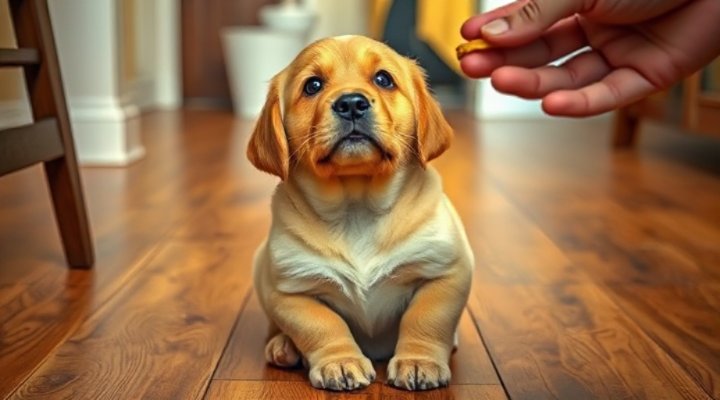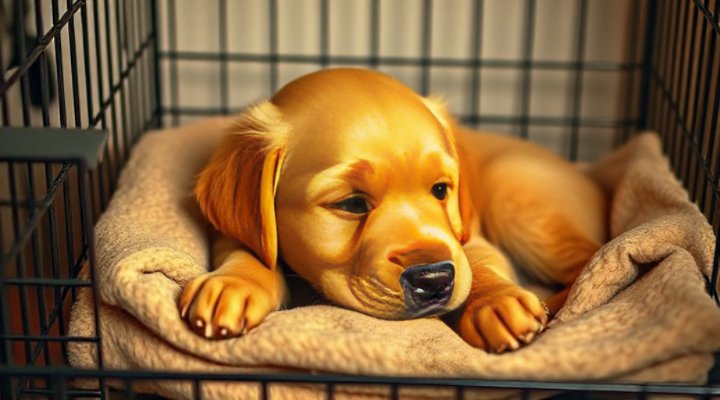Training a golden retriever puppy is one of the most rewarding experiences for any dog lover. These fluffy bundles of joy are known for their intelligence, loyalty, and eagerness to please, making them excellent candidates for training. However, like all puppies, golden retrievers require patience, consistency, and the right techniques to ensure they grow into well-behaved adults. In this comprehensive guide, we’ll cover everything from basic commands to advanced training tips, ensuring your golden retriever puppy becomes the perfect companion.

Getting Started with Golden Retriever Puppy Training
Before diving into specific training techniques, it’s essential to understand the basics of puppy training. Golden retrievers are highly intelligent and respond well to positive reinforcement. This means rewarding good behavior with treats, praise, or playtime, rather than punishing bad behavior. For example, when your puppy sits on command, immediately reward them with a small treat and lots of praise. This reinforces the behavior and makes them more likely to repeat it.
Another crucial aspect of golden retriever puppy training is consistency. Puppies thrive on routine, so it’s important to establish clear rules and stick to them. If you allow your puppy to jump on the couch one day and scold them for it the next, they’ll become confused and less likely to follow your commands. Consistency also applies to all family members—everyone should use the same commands and rewards to avoid mixed signals.

Basic Commands Every Golden Retriever Puppy Should Know
Teaching your golden retriever puppy basic commands is the foundation of good behavior. Start with simple commands like ‘sit,’ ‘stay,’ ‘come,’ and ‘down.’ These commands not only make daily life easier but also keep your puppy safe in potentially dangerous situations. For instance, a reliable ‘come’ command can prevent your puppy from running into traffic or approaching an aggressive dog.
To teach ‘sit,’ hold a treat close to your puppy’s nose and slowly move it upward. As their head follows the treat, their bottom will naturally lower to the ground. As soon as they sit, say ‘sit’ and give them the treat. Repeat this process several times a day until your puppy masters the command. Similarly, for ‘stay,’ ask your puppy to sit, then take a step back while holding your hand out like a stop sign. If they remain seated, reward them. Gradually increase the distance and duration over time.
If you’re looking for more detailed guidance on basic commands, check out our article on Puppy Training: A Comprehensive Guide from Basics to Advanced Techniques.

Socialization: A Key Aspect of Golden Retriever Puppy Training
Socialization is one of the most important aspects of golden retriever puppy training. Proper socialization helps your puppy become comfortable with various people, animals, environments, and experiences, reducing the likelihood of fear or aggression later in life. The critical socialization period for puppies is between 3 and 14 weeks of age, so it’s essential to expose your golden retriever to as many positive experiences as possible during this time.
Start by introducing your puppy to different surfaces (grass, pavement, carpet), sounds (traffic, vacuum cleaners, doorbells), and people (children, men with beards, people wearing hats). Always ensure these experiences are positive—offer treats and praise to create happy associations. Puppy classes are also an excellent way to socialize your golden retriever while learning basic obedience. For more tips on socialization, visit the American Veterinary Medical Association.
Remember, socialization isn’t just about meeting other dogs. It’s about building confidence and teaching your puppy how to behave in various situations. A well-socialized golden retriever is more likely to be calm, friendly, and adaptable in new environments.

Crate Training Your Golden Retriever Puppy
Crate training is an invaluable tool for golden retriever puppy training. When done correctly, a crate becomes a safe, comfortable space for your puppy—akin to a den. It also aids in housebreaking, prevents destructive behavior when unsupervised, and provides a secure place for your puppy to rest. However, it’s crucial to introduce the crate positively to avoid creating negative associations.
Start by placing the crate in a quiet area of your home with the door open. Add soft bedding and a few toys to make it inviting. Encourage your puppy to explore the crate by tossing treats inside. Once they’re comfortable entering voluntarily, begin feeding them meals near the crate, then gradually move the food bowl inside. Over time, you can start closing the door for short periods while you’re present, gradually increasing the duration.
Never use the crate as punishment, as this will create negative associations. For more detailed crate training techniques, check out our guide on Crate Training Puppy: How to Make Your Puppy Love Their Crate.

Advanced Golden Retriever Puppy Training Tips
Once your golden retriever puppy has mastered basic commands, you can move on to more advanced training. This might include tricks like ‘shake,’ ‘roll over,’ or ‘play dead,’ as well as practical skills like walking nicely on a leash or settling calmly when guests arrive. Advanced training strengthens the bond between you and your puppy while providing mental stimulation that prevents boredom and destructive behaviors.
One effective advanced technique is ‘capturing,’ where you reward behaviors your puppy offers naturally. For example, if your puppy stretches into a ‘down’ position on their own, say ‘down’ and give them a treat. This helps them associate the word with the action. Another method is ‘shaping,’ where you reward successive approximations of the desired behavior. If you’re teaching ‘roll over,’ you might first reward for lying down, then for turning their head, then for rolling slightly, until they complete the full roll.
For more advanced training ideas, the American Kennel Club offers excellent resources.
Common Challenges in Golden Retriever Puppy Training
While golden retrievers are generally eager to please, puppy training isn’t without its challenges. Common issues include mouthing, jumping up, and excessive barking. These behaviors are normal for puppies but need to be addressed early to prevent them from becoming ingrained habits.
For mouthing, redirect your puppy to an appropriate chew toy whenever they nip at hands or clothing. If they persist, stand up and withdraw attention briefly to teach them that mouthing ends playtime. For jumping, turn away and ignore your puppy when they jump up, only giving attention when all four paws are on the ground. Consistency is key—every family member must follow the same rules for these techniques to be effective.
If you’re struggling with specific behavior issues, our article on Dog Behavior Problems Solutions: Expert Tips for Common Issues might be helpful.
Conclusion: The Joy of Training Your Golden Retriever Puppy
Training your golden retriever puppy is an investment that pays dividends for years to come. Not only does it ensure good behavior, but it also strengthens your bond and provides mental stimulation for your growing dog. Remember to be patient—puppies learn at different paces, and setbacks are normal. Celebrate small victories and keep training sessions short, fun, and positive.
With consistency, positive reinforcement, and plenty of love, your golden retriever puppy will grow into a well-mannered, joyful companion. For more puppy training resources, explore our Puppy Training Tips: Cultivating Good Behavior from an Early Age.
Related Keywords: golden retriever puppy training, puppy training tips, golden retriever training, dog training, puppy behavior, positive reinforcement training, crate training puppies, puppy socialization

